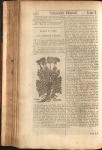Chap. 114. Of Carrots, Garden.
I. The Names. It is called in Greek, Σταφυλινοσ, και σαφυλινοσ ημεγος: In Latin, Staphylinus, Staphylinus Hortensis, and Pastinaca tenuifolia Hortensis: in English, Carrot, and Garden Carrot.
II. The Kinds. Carrots are either Garden or Wild. The Garden, are,
1. Pastinaca tenuifolia sativa lutea, Yellow Garden Carrots.
2. Pastinaca tenuifolia altera sativa atro-rubens, Red Garden Carrots.
III. The Description. The Yellow Carrot has a large long Root, great or thick, and yellow, big above, and small pointed below, without any Fangs or Twines, of a pleasant sweet Taste, and therefore generally spent for Food. From this Root spring forth several long Leaves, and well spread, made up of many thin, cut, deep, green Leaves, divided into many parts : among which rises up a round Stalk, a yard, or more, high, bearing large Tufts of Umbles of white flowers, which croud close together, and spread not much, but turn into small whitish rough hairy Seed, sticking one to another.
IV. The Red Carrot has a Root round and long, thick above and small below, running to a point as the other, and differs from it only in the color, which is wholly red quite throughout : from this Root rise many winged Leaves, much cut and divided into many other Leaves; and those cut again, and divided into many parts, of a deep green color like the former; some whereof in Autumn will turn to be of a fine Red or Purple (the beauty of which makes several Persons many times to gather the Leaves, to stick them in their Hats, or Heads, or Bosoms, or pin them on their Sleeves instead of Feathers) from among which Leaves rises up a Stalk, bearing many Leaves likewise upon it, but not so high as the Parsnip, being about a yard high, bearing many Tufts or Umbles of white flowers, which turn into small rough Seed, seeming as if it were hairy, and smelling gratefully enough, if rubbed between the Fingers. In a word, the whole Plant differs very little from the former, except in the redness of the Root.
V. Now here is to be noted,
1. That the Yellow Carrot is of two forts, viz.
The long and the short.
One of the long sorts is of a pale yellow, and this has the greatest and longest Root, and likewise the greatest head of Green : this for the most part is the worst sort of Carrot, not being so sweet and firm as the other.
The other long sort is of a deep Gold yellow color, having a smaller head of Green Leaves upon it, and this is always the best and sweetest. Parkinson says, that yellow Carrots, by sometimes sowing themselves, do oftentimes make their Roots become White. The short Roots are also divided into pale and deep yellow, or Golden color.
2. That the red Carrots, besides those which are red quite throughout, there is another, whose Root is red without for a pretty way inwards, but the middle is yellow.
VI. The Places. They are only Sown in Gardens, or other manured Fields, chosen and fitted out for that purpose, and delight to grow in a Sandy and light ground, that their Roots may the more easily pierce deep downwards, which in a stiff clay ground they cannot so well do.
VII. The Times. They are to be sown in March and April, the first year they only strike down their Root and the year following they bring forth their Flower and Seed. In Carolina I saw a Carrot above four years old, which brought forth its ripe Seed in the fifth year : The reason thereof I conceive to be, because the Master of the House cut off every year its green Tops, that it might not Seed, whereby the Root grew very great, as also the green head the fifth year, which was four or five times as big as any ordinary Carrot head : This head he let stand for Seed, and it produced him an incredible quantity thereof, very fair, and nearly twice as large as ordinary Carrot Seed.
IX. The Qualities. The Seed is hot and dry in the first Degree, Aperitive, Discussive, Diuretick, Carminative, Stomatick, Nephritick, Hysterick, and Alterative : The Roots are Sweet, Flatulent, Analeptick, and Spermatogenetick.
IX. As to their Specification, Preparations and Virtues, they are the same with those of the Wild Carrot, treated of in the next Chapter, to which we refer you; but with this note, that these Garden Kinds are nothing near so strong and powerful as those of the Wild Kinds, the Seeds of both being chiefly used in Medicine : As for the Roots, the Garden Kind a thousand fold exceed the Wild for Food, not only for the pleasure of Eating them, but also for their Analeptick or Nourishing faculty.
Botanologia, or The English Herbal, was written by William Salmon, M.D., in 1710.
This chapter has been proofread by Henriette.

 Page 194
Page 194
